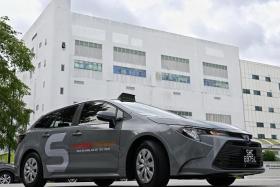New trains set to be serviced in Singapore
It will reduce downtime and lower costs, which can trickle down to commuters
New trains to ply the North-South and East-West MRT lines and the revamped Bukit Panjang LRT system are set to be serviced in Singapore.
This is a key step towards becoming self-sufficient in this field and bringing jobs and savings to Singapore, while cutting downtime.
The Land Transport Authority (LTA) said yesterday its contracts for new trains and railway systems now ask suppliers to base servicing support here.
This reduces the downtime of the trains, as faulty parts no longer have to be sent back to manufacturers overseas.
This also lowers the cost, bringing about savings that can trickle down to commuters.
"Under this agreement, suppliers are encouraged to set up local support offices in Singapore and provide (public transport operators) with training, technical and logistics support to ensure that the trains and other systems are rigorously serviced over their entire life cycle," LTA said.
This would apply to the 66 new trains to replace the first-generation vehicles on the North-South and East-West MRT lines, along with the new trains to be brought in as part of the Bukit Panjang LRT system revamp.
The supplier for both projects, Canadian engineering giant Bombardier, has already committed to setting up a Centre of Excellence here, which would provide maintenance support, allowing for faster rectifications and repairs.
A Bombardier spokesman said the centre will be ready by the second half of next year.
During the signing of a memorandum of understanding between SMRT, SBS Transit and ST Engineering in June, Coordinating Minister for Infrastructure and Minister for Transport Khaw Boon Wan said such arrangements would create "attractive and stable jobs for our rail workers".
BENEFITS
Yesterday, Mr Khaw visited ST Engineering's Electronic Card Repair Facility for Rail in Boon Lay, which fixes the cards that control the speed and doors of the trains, among other things. An average train can have 800 such cards.
SMRT Trains chief executive officer Lee Ling Wee said rail operators benefit in three ways.
First, if the electronic cards are sent overseas, it could take months or years to service them.
"But if it's done in Singapore, it would take weeks or even days."
Second, companies get a better handle on the fault and repairs when cards are serviced locally. Otherwise, they would have to rely on defect reports.
Lastly, settling the servicing locally means the cost structure is more flexible, helping operators optimise costs.
"This in turn lowers the cost of running train services in Singapore, and therefore it is beneficial for commuters as well," said Mr Lee.
National University of Singapore transport infrastructure expert Raymond Ong said it is "very important" for Singapore to have its own train servicing capabilities. The railway system is set to be the backbone of Singapore's public transport.
Said Dr Ong: "We can't afford to have systems that are not reliable and prone to disruptions due to maintenance issues."
Get The New Paper on your phone with the free TNP app. Download from the Apple App Store or Google Play Store now



